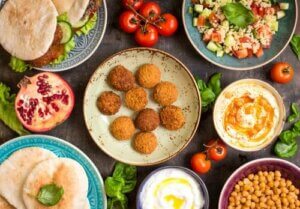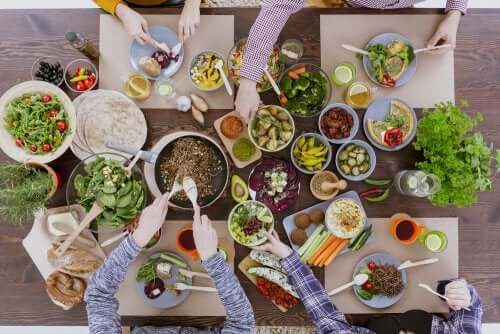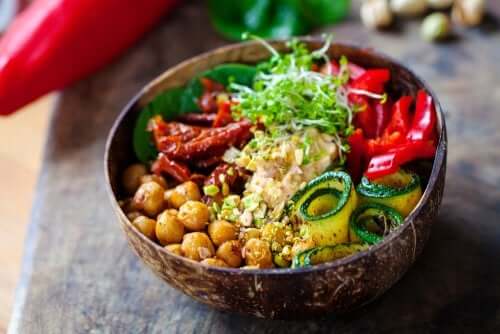Common Myths About Vegetarianism


Written and verified by the nutritionist Silvia Zaragoza
The vegetarian diet has become a lifestyle for many people worldwide, especially young people. However, even though the American Academy of Nutrition and Dietetics has come out in favor of its use at any time of life (as long as it’s supervised by a dietitian-nutritionist), there are still some myths about vegetarianism.
Would you like to know what they are? Read on.
Iron deficiency anemia, one of the most deeply-rooted myths about vegetarianism
Iron is an essential mineral for our blood, as it’s part of hemoglobin, which is responsible for oxygenating our body. In addition to this, it has a high antioxidant power and prevents us from feeling tired, and stimulates our mood and concentration.
We can find it in both animal and vegetable foods. However, the degree of absorption varies. It’s around 15-35% in meat, fish and eggs, compared to 1-20% in vegetables. However, this can vary as we’ll see below.
Even the absorption mechanism is different. Both types are absorbed in the intestine, but the vegetable iron is regulated by physiological needs. For example, during menstruation or a hemorrhage, our bodies will absorb greater amounts due to losses.

The main sources of iron are legumes, nuts, green leafy vegetables, and whole grains such as oatmeal. Another factor that makes it difficult to absorb is the presence of phytates and oxalates, as they tend to remove it, along with other minerals. Because of this, they’re known as sequestrants.
As a result, it’s advisable to soak these foods, cook them (boiled, steamed or baked), germinate them, or crush them. In this way, these sequestrants are deactivated.
Other good advice is to consume them along with a food rich in vitamin C, like bell peppers, oranges, tangerines, kiwis or lemons. At the same time, you should avoid any milky foods in the same meal, as well as coffee and tea.
Other myths about vegetarianism or veganism
If you don’t eat dairy foods, how will you have healthy bones?
Calcium is indispensable for growth, and helps to reduce the risk of fractures and osteoporosis. And, if there’s one thing that’s been repeated over and over again, it’s that dairy is the only main source of calcium. But is it true?
Maybe we should ask a question at this point. Who are the ones who tell us about the dangers of not consuming dairy products? Have you looked up any information on the subject?
Well, it turns out that plant-based foods also have calcium, and so there’s no problem in reducing or avoiding dairy foods. This type of food isn’t indispensable. We can find calcium in almonds, beans, kale, broccoli, Brussels sprouts, and sesame seeds. It’s also present in tofu made with calcium salts. And, just as with iron, it’s essential to soak, cook, or grind the ingredients.
And, one last point regarding this mineral, it’s important to know that several factors influence the calcification of the bones.
- Firstly, we need to have optimal levels of vitamin D, as it favors its absorption. How do we achieve this? By sunbathing, at least 15 or 20 minutes a day, maintaining an adequate weight with healthy fat levels, and limiting the use of anti-inflammatory drugs such as ibuprofen.
- Secondly, it’s important to do strengthening exercise regularly.
Other healthy habits are:
- Consuming at least 4 or 5 portions of fruit, green vegetables, and other vegetables daily. Each portion is equivalent to one medium piece or two small pieces of fruit, or a handful of berries or grapes.
- Eating a handful or one tablespoon of nuts and seeds daily.
- Using virgin olive oil for cooking and seasoning dishes.
- Seasoning dishes with aromatic herbs and spices.
- Reducing the consumption of coffee and tea.
- Avoiding smoking and drinking alcohol.

Myths about vegetarianism: vegetable protein isn’t complete
Legumes lack methionine, and cereals lack lysine and threonine. Bearing this in mind, it’s quite logical to think that the statement above is true.
However, there’s a great option here: mixing vegetables with cereals! In this way, the deficiencies of amino acids are both compensated.
Firstly, there are legumes such as chickpeas, soybeans and beans, and cereals such as amaranth, which do contain all the essential amino acids. As do quinoa (it’s a pseudocereal), hemp seeds, and pistachios. So, this option of mixing is only applicable to lentils, peas, peanuts, rice, wheat, oats and millet.
Secondly, we can carry out this combining of ingredients, but not necessarily at the same meal. Why? Because our bodies store these proteins automatically as we eat them.
In conclusion, a vegetarian diet is totally healthy, as is a vegan diet, and can contain all the nutrients we need if we plan it right, despite the myths about vegetarianism which are so widespread.
The vegetarian diet has become a lifestyle for many people worldwide, especially young people. However, even though the American Academy of Nutrition and Dietetics has come out in favor of its use at any time of life (as long as it’s supervised by a dietitian-nutritionist), there are still some myths about vegetarianism.
Would you like to know what they are? Read on.
Iron deficiency anemia, one of the most deeply-rooted myths about vegetarianism
Iron is an essential mineral for our blood, as it’s part of hemoglobin, which is responsible for oxygenating our body. In addition to this, it has a high antioxidant power and prevents us from feeling tired, and stimulates our mood and concentration.
We can find it in both animal and vegetable foods. However, the degree of absorption varies. It’s around 15-35% in meat, fish and eggs, compared to 1-20% in vegetables. However, this can vary as we’ll see below.
Even the absorption mechanism is different. Both types are absorbed in the intestine, but the vegetable iron is regulated by physiological needs. For example, during menstruation or a hemorrhage, our bodies will absorb greater amounts due to losses.

The main sources of iron are legumes, nuts, green leafy vegetables, and whole grains such as oatmeal. Another factor that makes it difficult to absorb is the presence of phytates and oxalates, as they tend to remove it, along with other minerals. Because of this, they’re known as sequestrants.
As a result, it’s advisable to soak these foods, cook them (boiled, steamed or baked), germinate them, or crush them. In this way, these sequestrants are deactivated.
Other good advice is to consume them along with a food rich in vitamin C, like bell peppers, oranges, tangerines, kiwis or lemons. At the same time, you should avoid any milky foods in the same meal, as well as coffee and tea.
Other myths about vegetarianism or veganism
If you don’t eat dairy foods, how will you have healthy bones?
Calcium is indispensable for growth, and helps to reduce the risk of fractures and osteoporosis. And, if there’s one thing that’s been repeated over and over again, it’s that dairy is the only main source of calcium. But is it true?
Maybe we should ask a question at this point. Who are the ones who tell us about the dangers of not consuming dairy products? Have you looked up any information on the subject?
Well, it turns out that plant-based foods also have calcium, and so there’s no problem in reducing or avoiding dairy foods. This type of food isn’t indispensable. We can find calcium in almonds, beans, kale, broccoli, Brussels sprouts, and sesame seeds. It’s also present in tofu made with calcium salts. And, just as with iron, it’s essential to soak, cook, or grind the ingredients.
And, one last point regarding this mineral, it’s important to know that several factors influence the calcification of the bones.
- Firstly, we need to have optimal levels of vitamin D, as it favors its absorption. How do we achieve this? By sunbathing, at least 15 or 20 minutes a day, maintaining an adequate weight with healthy fat levels, and limiting the use of anti-inflammatory drugs such as ibuprofen.
- Secondly, it’s important to do strengthening exercise regularly.
Other healthy habits are:
- Consuming at least 4 or 5 portions of fruit, green vegetables, and other vegetables daily. Each portion is equivalent to one medium piece or two small pieces of fruit, or a handful of berries or grapes.
- Eating a handful or one tablespoon of nuts and seeds daily.
- Using virgin olive oil for cooking and seasoning dishes.
- Seasoning dishes with aromatic herbs and spices.
- Reducing the consumption of coffee and tea.
- Avoiding smoking and drinking alcohol.

Myths about vegetarianism: vegetable protein isn’t complete
Legumes lack methionine, and cereals lack lysine and threonine. Bearing this in mind, it’s quite logical to think that the statement above is true.
However, there’s a great option here: mixing vegetables with cereals! In this way, the deficiencies of amino acids are both compensated.
Firstly, there are legumes such as chickpeas, soybeans and beans, and cereals such as amaranth, which do contain all the essential amino acids. As do quinoa (it’s a pseudocereal), hemp seeds, and pistachios. So, this option of mixing is only applicable to lentils, peas, peanuts, rice, wheat, oats and millet.
Secondly, we can carry out this combining of ingredients, but not necessarily at the same meal. Why? Because our bodies store these proteins automatically as we eat them.
In conclusion, a vegetarian diet is totally healthy, as is a vegan diet, and can contain all the nutrients we need if we plan it right, despite the myths about vegetarianism which are so widespread.
All cited sources were thoroughly reviewed by our team to ensure their quality, reliability, currency, and validity. The bibliography of this article was considered reliable and of academic or scientific accuracy.
- Craig WJ, Mangels AR; American Dietetic Association. (2009) Position of the American Dietetic Association: vegetarian diets. J Am Diet Assoc, 109(7): 1266-82.
- Saunders AV, Craig WJ, Baines SK, Posen JS. (2009) Iron and vegetarian diets. Med J Aust, 199(S4): 11-6.
- Lucía Martínez Argüelles. Vegetarianos con ciencia. España, 1ªEd 2016. Ed. Arcopress.
- Ambroszkiewicz J, Klemarczyk W, Mazur J, Gajewska J, Rowicka G, Strucińska M et al. (2017). Serum Hepcidin and soluble transferrin receptor in the Assessment of Iron Metabolism in Children on a Vegetarian Diet. Biol Trace Elem Res, 180(2): 182-90.
- Knutson MD. (2010). Iron-sensing proteins that regulate hepcidin and enteric iron absorption. Annu Rev Nutr, 30_149-71.
- Lucías Martínez Argüelles. (2013). Calcio en dietas vegetarianas. Alimmenta. [Consultado el 31 de diciembre de 2019] Disponible en: https://www.dietistasnutricionistas.es/calcio-en-dietas-vegetarianas/.
This text is provided for informational purposes only and does not replace consultation with a professional. If in doubt, consult your specialist.








